Transcription of WHAT ARE THE DIFFERENCES BETWEEN …
1 California Budget Project Budget Brief August 1996. WHAT ARE THE DIFFERENCES BETWEEN . ASSESSMENTS, fees , AND TAXES? Local governments use a variety of means besides taxation to generate revenue, including fees and assessments. Since the passage of the 1978 property tax limitation initiative known as Proposition 13, local governments have increasingly turned to alternative methods of raising money to pay for specific services. Revenue from benefit assessments levied by cities more than quadrupled BETWEEN 1981 and 1994, although it continues to account for a very small portion ( percent) of total city revenue.
2 Assessments also account for a small portion of revenue for counties (.02 percent in 1993-94) and special districts (3 percent of non-enterprise special district revenue in 1992-93).(1). BETWEEN 1975-76 and 1993-94, the portion of city revenue accounted for by fees and service charges increased from 32 percent to 41 percent.(2) Counties' share of revenue from service charges remained constant at nine percent. Service charges have accounted for more than 70 percent of special district budgets during the past 20 years, mostly due to user fees charged for enterprise activities such as water and sewer.
3 (3). California laws authorizing local benefit assessments date back to the early years of this century, when local governments used assessments primarily to pay for physical improvements adjacent to the assessed land. Use of assessments as a local revenue source actually peaked during the early decades of the century. More recently, the state has authorized the use of assessments for a broad array of facilities and services ranging from fire suppression to pedestrian malls to the control of pests in the wine industry.(4) In recent years, local governments' use of fees and assessments has come under increasing criticism from taxpayers-rights groups, who allege that local jurisdictions disguise tax increases as fees or assessments to circumvent voter approval requirements for new taxes.
4 Local governments respond that they merely follow a long-established practice of charging property owners for services or improvements that benefit the owners' land. The debate about fees and assessments will attract more attention in the months to come. The November ballot will include an initiative that would amend the state constitution to make it more difficult for local governments to raise revenue through fees and assessments. To promote an informed debate, this Budget Brief describes the DIFFERENCES BETWEEN taxes, fees , and assessments and the purposes for which they are used.
5 These three revenue tools -- and their uses -- are legally distinct from one another. In practice, however, there is considerable overlap among them. An activity financed by taxes in one jurisdiction might be financed through fees or assessments in another jurisdiction. WHAT CONSTITUTES "LOCAL GOVERNMENT?". There is more to local government than cities and counties. Two other major forms of local government are school and community college districts and special districts. The categories of local government differ in terms of the kinds of power they possess and the range of services they provide.
6 Cities and counties are general purpose governments that provide a wide range of services to local residents. The authority of counties and general law cities is limited to that expressly provided by the state constitution or by statute. Charter cities' powers are defined by their individual charters, by the constitution, and, with respect to matters of statewide concern, by the Legislature.(5). Special districts are limited-purpose governments that differ from cities and counties in important ways. Special districts are usually formed to provide a specific service, such as fire protection, water service, or street lighting, to a defined geographic area.
7 Some special districts, such as county service areas, provide multiple services. State laws set out the types of special districts that can be formed as well as the rules for forming them. Cities and counties can make and enforce rules governing behavior and activities (police power), whereas special districts' powers are generally restricted to raising money and providing a service. Special districts may be independent, with their own separately elected governing boards, or they may be dependent, meaning the city council or county board of supervisors serves as the governing board.
8 Roughly two-thirds of California's approximately 4,900 special districts are independent. Enterprise special districts, which provide services such as water, electricity, or transit that are used by individual customers, are funded primarily through user fees . Non- enterprise districts, which provide services such as parks or fire protection that benefit the entire community, rely more heavily on taxes. School and community college districts exist to provide one service: education. Unlike cities, counties, and special districts, school districts are guaranteed a minimum level of funding by the State Constitution.
9 In addition to their property tax allotment, school districts can raise revenues locally through voter-approved special taxes, assessments for some purposes, and developer fees . WHAT IS A TAX? A tax is a charge against an individual or landowner, which pays for public services and facilities that provide general benefits. There need not be a direct relation BETWEEN an individual taxpayer's relative benefit from services or facilities and the tax he or she pays. Counties, school districts, and special districts can only impose taxes specifically authorized by the Legislature.
10 Cities may impose any tax not otherwise prohibited by state law.(6) The state has "reserved" a number of taxes for its own purposes, prohibiting local governments' use of these revenue sources. For example, the state reserves the right to tax cigarettes and alcoholic beverages. There are two basic categories of taxes, general and special: General taxes are defined as those that generate revenue for the general operation of government. In other words, revenues from a general tax may be used for any purpose the governing board chooses to spend it on. State statutes lay out requirements for local governments planning a new or increased general tax.











